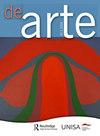Noisy Surfaces: Vulnerability and Art in Human–Ocean Relations
IF 0.1
0 ART
引用次数: 0
Abstract
Abstract At the shoreline, human and ocean activities often act in unproductive tension with one another. This article draws from encounters between the modernist architecture in the port city of Toamasina in Madagascar and the activities of the Indian Ocean at that location to sense how human–ocean binary lines might become more porous. The first part of the article sketches a material-discursive theory of the weathered hole in modernist architectural surfaces. It explores the hole as a vital collective of queer otherings to the specific land-centred individualistic subject-hood of modernist Man, a specific figuration of a human who draws binary lines to separate itself out from the “natural world”. The second part of the article argues that artistic inquiry is well positioned to sense into the activities of the hole. It looks to how the hole at the surface of modernist Man can co-shape the specific human–ocean relationship that forms at this shoreline. Such inquiry is explored through my solo exhibition titled Static Drift, held at the Wits Art Museum in Johannesburg in 2021. Sensing, the exhibition reveals, has the potential for listening to binary lines as they erect a surface that both pushes away yet also receives what has been pushed. In Static Drift, being vulnerable through human perceptions was highlighted as a critical mode for sensory attunement to the relationships that form at such surfaces. This article argues that the sonic is a useful sensory mode for opening perceptions toward what is not yet perceived in surface–hole relationships. The sonic opens sites for ontological thinking into human–ocean relations by sensing into the re-orienting potentials that noise offers for thinking about disrupting binaried surfaces.嘈杂的表面:人类与海洋关系中的脆弱与艺术
本文章由计算机程序翻译,如有差异,请以英文原文为准。
求助全文
约1分钟内获得全文
求助全文

 求助内容:
求助内容: 应助结果提醒方式:
应助结果提醒方式:


